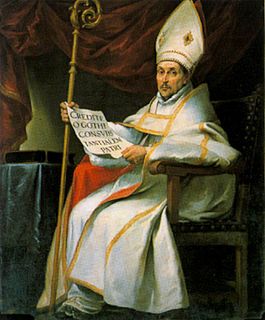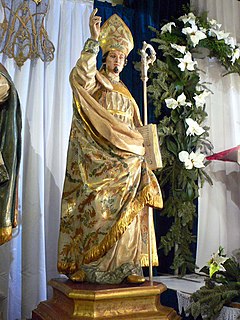The Second Council of Seville (or Seville II) was a synod of the ecclesiastical province of Baetica held in 619. It took place in the metropolis of Seville under the Archbishop Isidore. It was the first synod in Baetica since 592. It came shortly after a military campaign by the King Sisebut reincoporated a large part of Baetica into the Visigothic kingdom. This territory had previously been part of the Byzantine province of Spania. Its reincorporation would allow the bishop of Málaga to attend the synod. [1]

A synod is a council of a church, usually convened to decide an issue of doctrine, administration or application. The word synod comes from the Greek σύνοδος (sýnodos) meaning "assembly" or "meeting", and it is synonymous with the Latin word concilium meaning "council". Originally, synods were meetings of bishops, and the word is still used in that sense in Catholicism, Oriental Orthodoxy and Eastern Orthodoxy. In modern usage, the word often refers to the governing body of a particular church, whether its members are meeting or not. It is also sometimes used to refer to a church that is governed by a synod.
An ecclesiastical province is one of the basic forms of jurisdiction in Christian Churches with traditional hierarchical structure, including Western Christianity and Eastern Christianity. In general, an ecclesiastical province consists of several dioceses, one of them being the archdiocese, headed by metropolitan bishop or archbishop who has ecclesiastical jurisdiction over all other bishops of the province.
A metropolis religious jurisdiction, or a metropolitan archdiocese, is an episcopal see whose bishop is the metropolitan bishop of an ecclesiastical province. Metropolises, historically, have been important cities in their provinces.
The Second Council of Seville dealt solely with ecclesiastical and theological matters—diocesan rights, noncanonical ordinations, unjust clerical depositions, territorial jurisdictional disputes—and laid out procedures, often based on Roman vulgar law, for resolving them. [1] Many canons were devoted to refuting a certain Gregory, described as a Syrian bishop of the Acephali (literally, "headless"), which in context means those who denied the Three Chapters (i.e., headings). [2] Gregory attended the synod in person. [3] The council did not address the laity of Baetica, nor the Visigothic state, although two royal officials were in attendance: Sisiclus, the director of public affairs (rector rerum publicarum), and Suanila, the director of fiscal affairs (rector rerum fiscalium). [1]

Roman law is the legal system of ancient Rome, including the legal developments spanning over a thousand years of jurisprudence, from the Twelve Tables, to the Corpus Juris Civilis ordered by Eastern Roman Emperor Justinian I. Roman law forms the basic framework for civil law, the most widely used legal system today, and the terms are sometimes used synonymously. The historical importance of Roman law is reflected by the continued use of Latin legal terminology in many legal systems influenced by it, including common law.

Syriac Christianity is the form of Eastern Christianity whose formative theological writings and traditional liturgy are expressed in the Syriac language.
In church history, the term acephali has been applied to several sects that supposedly had no leader. E. Cobham Brewer wrote, in Dictionary of Phrase and Fable, that acephalites, "properly means men without a head." Jean Cooper wrote, in Dictionary of Christianity, that it characterizes "various schismatical Christian bodies". Among them were Nestorians who rejected the Council of Ephesus condemnation of Patriarch Nestorius of Constantinople, which deposed Nestorius and declared him a heretic.
The canons of the Second Council of Seville were copied into the Hispana , a great collection of Iberian and African conciliar records, later in the seventh century. A Third Council of Seville (or Seville III) appears to have met around 624, but its canons were subsequently suppressed. [4]
For the legal system of ecclesiastical canons, see Canon law and Canon law.

Alaric II was the King of the Visigoths in 484–507. He succeeded his father Euric as king of the Visigoths in Toulouse on December 28, 484; he was the great-grandson of the more famous Alaric I, who sacked Rome in 410. He established his capital at Aire-sur-l'Adour in Aquitaine. His dominions included not only the majority of Hispania but also Gallia Aquitania and the greater part of an as-yet undivided Gallia Narbonensis.

Saint Isidore of Seville, a scholar and, for over three decades, Archbishop of Seville, is widely regarded in the Catholic Church as the last of the Church Fathers, as the 19th-century historian Montalembert put it in an oft-quoted phrase, "The last scholar of the ancient world."

The Second Council of Constantinople is the fifth of the first seven ecumenical councils recognized by both the Eastern Orthodox Church and the Roman Catholic Church. It is also recognized by the Old Catholics and others. Protestant opinions and recognition of it are varied. Some Protestants, such as Calvinists and Lutherans, recognize the first four councils, whereas most Anglo-Catholics accept all seven. Constantinople II was convoked by the Byzantine Emperor Justinian I under the presidency of Patriarch Eutychius of Constantinople. It was held from 5 May to 2 June 553. Participants were overwhelmingly Eastern bishops—only sixteen Western bishops were present, including nine from Illyricum and seven from Africa, but none from Italy—out of the 152 total.

Athanagild was Visigothic King of Hispania and Septimania. He had rebelled against his predecessor, Agila I, in 551. The armies of Agila and Athanagild met at Seville, where Agila met a second defeat. Following the death of Agila in 554, he was sole ruler for the rest of his reign.

Reccared I was Visigothic King of Hispania and Septimania. His reign marked a climactic shift in history, with the king's renunciation of Arianism in favour of Catholicism in 587.

Saint Leander of Seville, was the Catholic Bishop of Seville. He was instrumental in effecting the conversion of the Visigothic kings Hermengild and Reccared to Catholicism. His brother was the encyclopedist St. Isidore of Seville.
The Third Council of Toledo (589) marks the entry of Visigothic Spain into the Catholic Church, and known for codifying the filioque clause into Western Christianity. The council also enacted restrictions on Jews, and the conversion of the country to Catholic Christianity led to repeated conflict with the Jews.
The Council of Epaone or Synod of Epaone was held in September 517 at Epaone in the Burgundian Kingdom.
Theudis, was king of the Visigoths in Hispania from 531 to 548. He was the sword-bearer of Theodoric the Great, who sent him to govern the Visigothic kingdom during the minority of Amalaric, the son of king Alaric II and Theodegotha, the daughter of king Theodoric.
Liuvigild, Leuvigild, Leovigild, or Leovigildo, was a Visigothic King of Hispania and Septimania from 568 to April 21, 586. Known for his Codex Revisus or Code of Leovigild, a unifying law allowing equal rights between the Visigothic and Hispano-Roman population, his kingdom covered modern Portugal and most of modern Spain down to Toledo. He was born circa 525.

The Kingdom of the Suebi, also called the Kingdom of Gallæcia, was a Germanic post-Roman kingdom that was one of the first to separate from the Roman Empire. Based in the former Roman provinces of Gallaecia and northern Lusitania, the de facto kingdom was established by the Suebi about 409, and during the 6th century it became a formally declared kingdom identifying with Gallaecia. It maintained its independence until 585, when it was annexed by the Visigoths, and was turned into the sixth province of the Visigothic Kingdom in Hispania.
The Council of Agde was a regional synod held in September 506 at Agatha or Agde, on the Mediterranean coast east of Narbonne, in the Septimania region of the Visigothic Kingdom, with the permission of the Visigothic King Alaric II.
The First Council of Orléans was convoked by Clovis I, King of the Franks, in 511. Clovis called for this synod four years after his victory over the Visigoths under Alaric II at the Battle of Vouillé in 507. The council was attended by thirty-two bishops, including four metropolitans, from across Gaul, and together they passed thirty-one decrees. The bishops met at Orléans to reform the church and construct a strong relationship between the crown and the Catholic episcopate, the majority of the canons reflecting compromise between these two institutions.
Collections of ancient canons contain collected bodies of canon law that originated in various documents, such as papal and synodal decisions, and that can be designated by the generic term of canons.

Spania was a province of the Byzantine Empire from 552 until 624 in the south of the Iberian Peninsula and the Balearic Islands. It was established by the Emperor Justinian I in an effort to restore the western provinces of the Empire.
Maximus was the first Visigothic bishop of Zaragoza (Hispania) in 592–619. He was also a theologian and historian.

Ariamir was the Suevic King of Galicia, with his capital at Bracara, from 558/9. The bishops of the First Council of Braga recorded Ariamir as the king who summoned them and under whose auspices they deliberated. Because the bishops mention theirs as being the first Nicene synod to be held in Galicia in a long while, Ariamir is sometimes assumed to have been the king who led the conversion of his people from Arianism to orthodoxy and thus to have lifted the ban on Nicene councils.

Saint Fulgentius of Cartagena, born in Cartagena in the 6th century and died in 630, was Bishop of Ecija (Astigi), in Hispania.
De fisco Barcinonensi is a letter (epistola) from a group of bishops in the province of Tarraconensis in the Visigothic Kingdom to the treasury agents in Barcelona. The letter reminds the officials of the fixed rate of public tribute and demands that exactions in excess of that amount should stop. In the manuscripts, De fisco is preserved after the acts of the Second Council of Barcelona of 540, but its signatories are mostly those of the acts of the First Council of Zaragoza of 592. Most scholars believe it should be dated in connexion with the latter council. The bishops describe themselves as "all [those] who contribute to the fisc of the city of Barcelona", but the bishop of Barcelona, Ugnas, did not sign. The location of the regional fiscal administration in Barcelona perhaps explains why that city survived the Islamic conquest better than the provincial capital, Tarragona.











